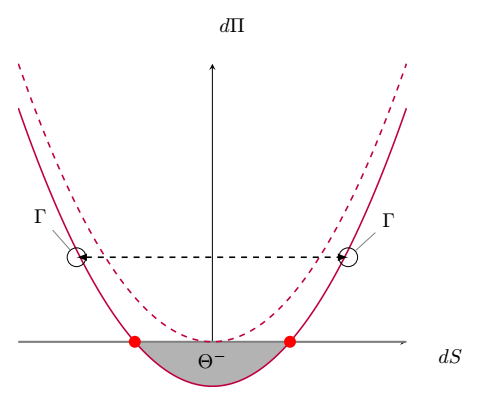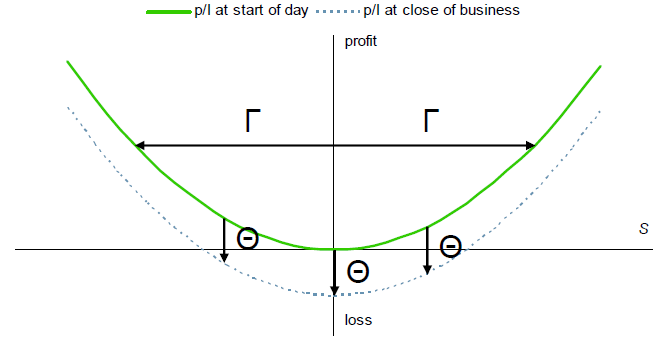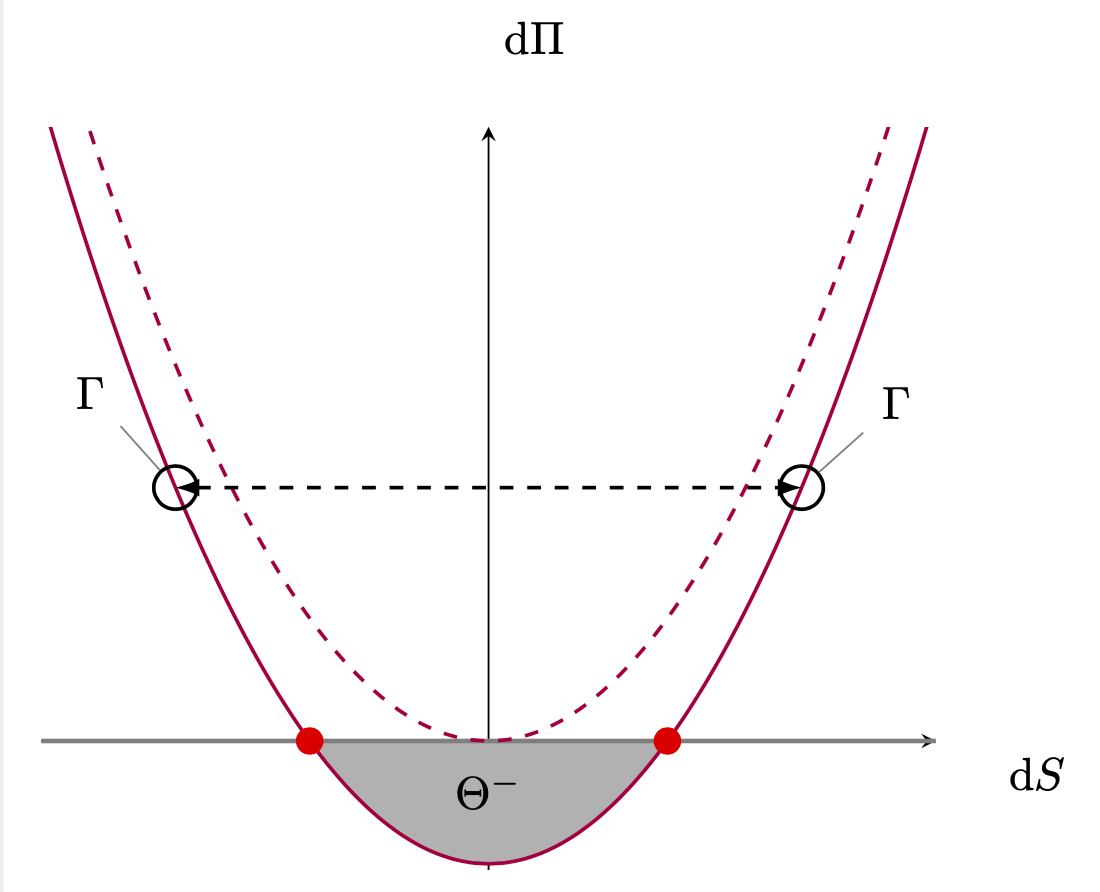**Question**
I need to automate calculations.
Strangely, declaring function by `\pgfmathdeclarefunction{PnL}` does not allow me to use the calculations when I call `Pnl{3.5}` and get the `y` coordinate.
Details in the code.

**Next step**
Of course animation :) The dashed curve will move along the y axis from its orinal position (dashed) to south, displaying more and more of the gray area.
```
\documentclass[border =2mm]{standalone}
\usepackage{tikz}
\usetikzlibrary{
calc,
intersections,
positioning,
}
\usepackage{pgfplots}
\pgfplotsset{compat=1.16}
\usepgfplotslibrary{
fillbetween,
}
\begin{document}
\newcommand*{\ShowIntersection}{
\fill
[name intersections={of=PnL and line, name=i, total=\t}]
[red, opacity=1, every node/.style={above left, black, opacity=1}]
\foreach \s in {1,...,\t}{(i-\s) circle (3pt)
node [above] {}};
}
\begin{tikzpicture}
\pgfmathdeclarefunction{PnL}{0}{\pgfmathparse{0.5*(x^2)-2}}
\begin{axis}[%customaxis2,
axis lines=middle,
xtick={\empty},
ytick={\empty},
ytick = {0},
ticklabel style={font=\scriptsize},
xlabel=$dS$,
ylabel=$d\Pi$,
xlabel style={at={(ticklabel* cs:1)}, xshift=12.5pt, anchor=north west},
ylabel style={at={(ticklabel* cs:1)}, yshift=12.5pt, anchor=south west},
samples = 51,
% domain = -3:3,
% xmin = -2, xmax = 5,
% ymin = -5, ymax = 10,
]
% X axis
\addplot[name path=line, gray, samples=2,no markers, line width=1pt] {0};
% curve
\addplot[purple,dashed,samples=51,smooth,thick, mark=none, ] {PnL+2};
% dashed curve, inital position
\addplot[purple,samples=51,smooth,name path=PnL, thick, mark=none, ] {PnL};
%filled area
\addplot fill between[
of = PnL and line,
split, % calculate segments
every even segment/.style = {white}, %Only trick I found to avoi
every odd segment/.style = {gray!60}
] {};
% red intersection points to X axis
\ShowIntersection
% cord but too manual
\coordinate (P) at (-3.5, 3.8);
% \coordinate (P) at (-3.5, \Pnl(-3.5) );
\coordinate (Q) at (3.5, 3.8);
% too manual
\node[pin=130:$\Gamma$,draw=black,circle] at (-3.5, 3.8) {};
%\node[pin=130:$\Gamma$,draw=black,circle] at (-3.5, \Pnl(-3.5)) {};
\node[pin=40:$\Gamma$,draw=black,circle] at (3.5, 3.8) {};
% too manual
\draw [latex-latex,dashed, thick, name path global=HorizontalLine] (P) -- (Q) node[above] {};
% too manual, but did not manage to place it in the center of the filled area
\draw (0,-0.8) node {$\Theta^{-}$};
\end{axis}
\end{tikzpicture}
\end{document}
```
**Note**
The orginal graph

When declaring a function, you may want to specify and use the variables. In your case this may mean something like
```
\pgfmathdeclarefunction{PnL}{1}{\pgfmathparse{0.5*(#1*#1)-2}}
```
where `{1}` says that this is a function of one variable, and `#1` represents this argument. Note that I use `#1*#1` instead of `#1^2` since pgf has somewhat strange conventions concerning the sign. An arguably more user-friendly way to declare the function is to use the key
```
declare function={PnL(\x)=0.5*\x*\x-2;},
```
instead. I made a few more unrelated changes.
```
\documentclass[border =2mm]{standalone}
\usepackage{amsmath}
\newcommand{\diff}{\mathop{}\!\mathrm{d}}
\usepackage{pgfplots}
\pgfplotsset{compat=1.17}
\usepgfplotslibrary{fillbetween}
\begin{document}
\newcommand*{\ShowIntersection}{
\fill
[name intersections={of=PnL and line, name=i, total=\t}]
[red, opacity=1]
foreach \s in {1,...,\t}{(i-\s) circle [radius=3pt]};
}
\begin{tikzpicture}
% \pgfmathdeclarefunction{PnL}{1}{\pgfmathparse{0.5*(#1*#1)-2}}
\begin{axis}[%customaxis2,
declare function={PnL(\x)=0.5*\x*\x-2;},
axis lines=middle,
xtick={\empty},
ytick={\empty},
ytick = {0},
ticklabel style={font=\scriptsize},
xlabel=$\diff S$,
ylabel=$\diff\Pi$,
xlabel style={at={(ticklabel* cs:1)}, xshift=12.5pt, anchor=north west},
ylabel style={at={(ticklabel* cs:1)}, yshift=12.5pt, anchor=south west},
samples = 51,
% domain = -3:3,
% xmin = -2, xmax = 5,
ymin ={PnL(0)-0.1}, ymax = 10,
]
% X axis
\addplot[name path=line, gray, samples=2,no markers, line width=1pt] {0};
% curve
\addplot[purple,dashed,samples=51,smooth,thick, mark=none] {PnL(x)+2};
% dashed curve, inital position
\addplot[purple,samples=51,smooth,name path=PnL, thick, mark=none] {PnL(x)};
%
%filled area
\addplot fill between[
of =PnL and line,
split, % calculate segments
every even segment/.style = {opacity=0}, %Only trick I found to avoi
every odd segment/.style = {gray!60}
] {};
% red intersection points to X axis
\ShowIntersection
%
\draw[latex-latex,dashed, thick, name path global=HorizontalLine,
nodes={solid,draw=black,circle},every pin edge/.style={solid,thin,gray,-}]
(-3.5,{PnL(-3.5))}) node[pin=130:$\Gamma$]{}
--
(3.5,{PnL(3.5))}) node[pin=40:$\Gamma$]{};
%
\draw (0,-0.8) node {$\Theta^{-}$};
\end{axis}
\end{tikzpicture}
\end{document}
```
